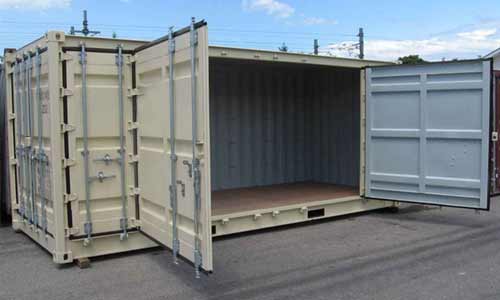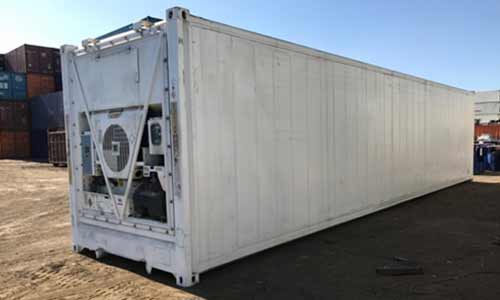When it comes to shipping via sea freight, the ocean carrier will typically release a container to the shipper. The shipper will then load their cargo into the container and prepare the documents for export.
However, not all containers are owned by ocean carriers. In certain instances, a shipper may directly lease a container from a container leasing company. This is often done for odd-sized or project cargo, avoiding detention charges and many other reasons.
This guide will show you a detailed step-by-step process on how to lease a shipping container. It will also contain an in-depth analysis that highlights in what scenarios container leasing may be advantageous and what the benefits of leasing are.
1. Decide on Container Type, Size and Quantity
If you’ve decided to lease a shipping container, the first step you’ll need to take is decide on the required container type, size and quantity. This will heavily depend on the items that you intend to ship.
Here’s a list of the most common container types that can be leased:
- Leasing Standard Containers (20’, 40’ and 45’ Containers) – These are the most common shipping containers. A 20’ standard container can accommodate 33 cbm while a 40’ standard container can accommodate 67 cbm. These containers are airtight, water-resistant and can easily be stacked on top of each other. They are also the most cost effective containers to lease.
- Leasing High Cube Containers (For 40’and 45’ Container) – A 40’ high cube container can accommodate up to 76 cbm and is also used for general cargo. These containers are similar to standard containers. The only difference is that standard containers are about 8′ 6″ (2.59m) tall, whereby high cube containers feature a height of about 9′ 6″ (2.89m). High cube containers are also commonly leased.
- Leasing Reefer Containers (20’ and 40’ Containers) – Temperature sensitive cargo is shipped in reefer containers. These types of leased containers have the ability to be temperature regulated and can facilitate a range from -30C to +30C.
- Leasing Open Top Containers – Like normal shipping containers, the difference is that open-top containers do not have a top covering. These types of containers are mainly loaded using a crane. Open Top containers are often leased when shipping heavy machinery, pipes, and metals or other types of bulky material.
- Leasing Flat Rack Containers – A flat track container is often leased for shipments that are out of gauge (OOG). It’s mainly used for cargo that is over the standard container dimensions with regards to weight and volume. These special containers are very rigid and are also leased for shipping heavy machinery, vehicles or project cargo.
- Leasing Other Container Types – There are also other types of containers that are leased such as, ISO Tank, ISO Reefer, Open Side and Half-Height Containers. These containers are leased for cargo that have special properties or requirements.
Special container types may be required if you have cargo that is out of gauge or temperature sensitive. Therefore, it’s best to assess the type of your cargo, the dimension, weight and other types of requirements.


2. Determine the Length and Type of Lease
The next step you’ll need to take is to ask yourself how long the lease of the containers will be and what type of lease you plan to engage in. Correctly identifying the lease type will enable you to calculate overall shipment or project costs more accurately.
| Lease Type | Duration | Drop-Off | Maintenance | Cost |
| One-Way Lease | Flexible | Flexible | Lessee | $ |
| Short-Term Lease: | 6 – 24 Months | Restrictive | Lessee | $$$ |
| Long-Term Lease: | 2 – 5 Years | Restrictive | Lessee | $$ |
| Master Lease: | Flexible | Flexible | Lessor | $$$ |
As there are several types of container leasing agreements, you may refer to the most common ones below:
One-Way Lease
One-Way Leases are used for single or one-time shipments. This means that shippers lease a single or multiple containers for one consignment, whereby the containers are subsequently returned to the container leasing company.
In a One-Way Lease, the lessor, or in this case the shipper, is responsible for maintaining and repairing the container if required. The duration of the lease, as well as the free time is negotiated between both parties. One way lease agreements are one of the most affordable container leasing types.
Short-Term Lease
As the name implies, a short-term container lease is designed to cater for leases that are between 6 – 24 months. While there are leasing companies who are able to facilitate short term leases for 3 – 6 months, it’s relatively uncommon.
Short term leases are also more expensive per day, than long-term leases. It’s typically the most expensive leasing agreement between lessor and lessee, thereby the lessee would be responsible for container repair and maintenance.
Long-Term Lease
For longer container leasing agreements, long-term leases are used. These leases can range from about to 2 – 5 years or even longer. Similar to short-term leases, the lessor is responsible for container repair and maintenance.
While it’s not uncommon for shippers to engage in long-term container leases more than 5 years, shippers may already consider purchasing a container in lieu of leasing.
Master Lease
A master lease for shipping containers provides the most amount of flexibility to lessees. Therefore, it’s mainly used by carriers and shippers who have substantial or unpredictable volume, and do not plan to own containers.
A master lease is also the most costly of all leases, as it comes with additional benefits, such as maintenance and repair, negotiable drop-off locations and more flexibility in terms of lease duration.
3. Look for a Suitable Container Leasing Company
Now that you have finalized the container type and size, as well as the type of leasing agreement, it’s time to select a suitable leasing company. There are many local and international companies that specialize in container leasing.
You may already know some of the most famous ones, such as Triton, Florens and Seaco. Container X-Change has a great list comparing the best container leasing companies in an overview.
Once you have identified multiple vendors and checked for the best rates and terms, narrow down your selection. Engage in deeper discussions to negotiate costs, lease duration, free days and drop-off locations. Finally, select your preferred leasing company.
4. Submit the Required Paperwork
A leasing company would require business information, the purpose and length of lease, and the commodity to be shipped. There is also a high probability of an advance deposit to protect the company from delays on container return.
Additionally, the container leasing company may also require a waiver to protect it from damages or legal responsibilities. Therefore, you’ll need to ensure that you prepare all documentation, in order to proceed.
Simply reach out to your preferred leasing company and ask them for all relevant documentation. Some container lessors will also request you to provide all required documentation during the inquiry process.
5. Arrange for Container Pick-up
Now that you’ve settled most of the administrative tasks, the loading, prime mover and trailer (occasionally a forklift or crane rental) needs to be arranged. You’ll need to plan the loading process carefully, in order to operate as cost effective as possible.
6. Settle the Payment
Recheck the lease agreement terms and provisions, the number of containers, lease period, agreed rates, and settlement period. Take note that the leasing company may require you to make a deposit depending on the contract terms.
Long-standing partnerships with leasing companies work with credit/debit facilities. For first-time lessors, it’s best to sort the payment terms as soon as possible.
When Should You Lease Shipping Containers?
There are several benefits of leasing shipping containers, compared to purchasing containers or having an all-in rate from ocean carriers. Let’s explore them in a little more detail.
Cash Flow Management
The capital needed to purchase containers is usually much larger compared to leasing containers. Brand new containers can cost anywhere from $2,000 to $10,000. General purpose containers are generally on the cheaper side, whereas specialized containers (e.g. ISO Tank, Reefer, ISO Reefer) are more expensive.
Depending on the cash flow of a company, it may be beneficial to lease containers instead of purchasing them. This is because the leasing cost is spread throughout the length of the shipment and can be even further extended with credit terms.
Asset Management
Certain companies also prefer to lease shipping containers, as their strategy is to remain asset light. Owning less assets makes them more flexible and allows them to enter and exit markets more easily.
Flexibility
Due to market conditions or changes in demand and supply planning, the required number of containers a company may need is often not firm. Certain container leasing agreements can facilitate more flexible container requirements, with regards to quantity, size and type.
This also means that you won’t be required to invest in multiple different container types and sizes, and are able to simply change the lease requirements for an increased leasing price.
Business Uncertainty
Certain companies may not be able to invest in shipping containers due to volatile market conditions, declining business or other types of challenges. In this scenario, the company may want to mitigate investment risk by leasing containers, instead of outright purchasing them.
Special Requirements
Container leasing may also be suitable for shippers who require special containers that are not readily available from ocean carriers. These types of containers could be specialized reefers, open-sided, open top, ISO Tank or other types of containers.
Container Customization
Leased containers can also be modified for longer term use. These containers could be customized with storage racks, temporary workspaces and other features.
Cost Avoidance
There is another advantage that leasing and buying containers have over using carrier-owned containers. For certain projects, complex unloading operations or sites that are further away from the port, the container may only be returned much later than the allowed free days.
Therefore, leased containers allow more flexibility in unloading and returning time. This could translate into huge detention savings, which the shipper or consignee may otherwise incur.

Get Free Course Access
If you enjoyed the article, don’t miss out on our free supply chain courses that help you stay ahead in your industry.

Gerrit Poel
Co-Founder & Writer
at freightcourse
About the Author
Gerrit is a certified international supply chain management professional with 16 years of industry experience, having worked for one of the largest global freight forwarders.
As the co-founder of freightcourse, he’s committed to his passion for serving as a source of education and information on various supply chain topics.
Follow us